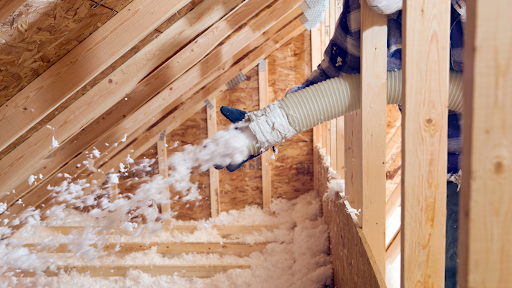When it comes to making your home comfortable and saving money on energy bills, insulation plays a crucial role. One effective way to improve your home’s energy efficiency is by using blown-in insulation. This type of insulation is popular because it fills in spaces that other insulation methods might miss. In this article, we will explain how blown-in insulation works and why it can help make your home more energy efficient.
What is Blown-In Insulation?
Blown-in insulation is a material made of tiny fibers or particles that are blown into wall cavities, attics, or other spaces in your home using special equipment. It is usually made from materials like fiberglass, cellulose (recycled paper), or mineral wool. Because it is loose and fluffy, blown-in insulation easily fills gaps, cracks, and hard-to-reach areas, providing a more complete layer of insulation compared to traditional batts or rolls.
How Blown-In Insulation Improves Energy Efficiency
The main purpose of insulation is to reduce heat transfer between the inside and outside of your home. During winter, insulation keeps warm air inside your home, and during summer, it helps keep the hot air out. This means your heating and cooling systems don’t have to work as hard, which saves energy and lowers utility bills.
Blown-in insulation is especially good at sealing off small gaps and spaces where air might leak. These leaks can cause drafts that make your home uncomfortable and force your heating or cooling system to run longer. By filling these spaces, blown-in insulation reduces air leakage and creates a barrier against heat loss or gain. This helps maintain a consistent temperature inside your home throughout the year.
Benefits of Using Blown-In Insulation
One of the biggest advantages of blown-in insulation is its ability to fill irregularly shaped areas and tight spaces that are difficult to insulate with traditional materials. This means it can be installed in older homes with uneven walls or around pipes, wires, and other obstacles without leaving gaps.
Another benefit is that blown-in insulation can be added on top of existing insulation, improving the overall thermal performance of your home without the need for extensive remodeling. This makes it a convenient option for homeowners looking to upgrade their insulation without major construction work.
Additionally, blown-in insulation materials like cellulose are often made from recycled content, making them an environmentally friendly choice. They also tend to settle and compact less over time, ensuring that your home remains well-insulated for many years.
Where Can Blown-In Insulation Be Installed?
Blown-in insulation is very versatile and can be used in different parts of your home. It is commonly installed in attic spaces, where it helps reduce heat loss through the roof. It can also be used in wall cavities, especially during home renovations or upgrades. In some cases, it is applied in floors or ceilings to improve overall energy efficiency.
Because blown-in insulation conforms to the space it fills, it is ideal for insulating areas that are hard to reach or have complicated shapes. Professional installers use specialized machines to blow the insulation into these spaces quickly and evenly.
How to Know if Your Home Needs Blown-In Insulation
If your home feels drafty, or your energy bills have been rising without any obvious reason, poor insulation might be the cause. Older homes, in particular, may have insufficient or damaged insulation that does not provide an effective barrier against heat transfer.
A professional energy audit or insulation inspection can help determine if blown-in insulation is a good solution for your home. Experts can measure the current insulation levels and identify gaps or weak spots that need to be filled. They can then recommend blown-in insulation as an upgrade to improve your home’s energy performance.
Conclusion
Improving your home’s energy efficiency is a smart investment that can make your living space more comfortable and reduce your utility bills. Blown-in insulation is an effective and flexible way to enhance your home’s insulation by filling gaps and hard-to-reach spaces where heat can escape. Whether you are building a new home or upgrading an older one, blown-in insulation offers a reliable solution to help maintain a consistent temperature year-round. Consider consulting with a professional to explore how blown-in insulation can benefit your home and save energy for years to come.

